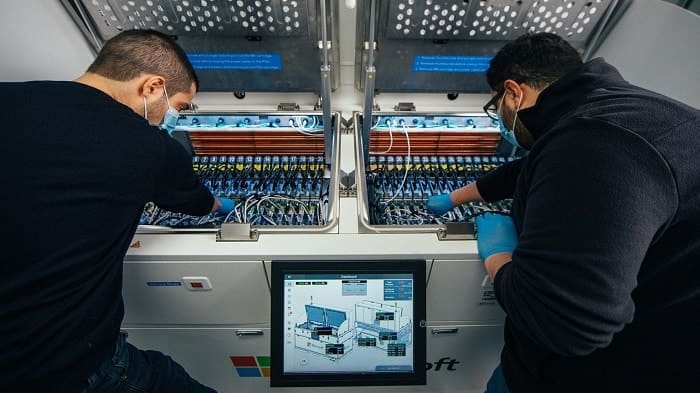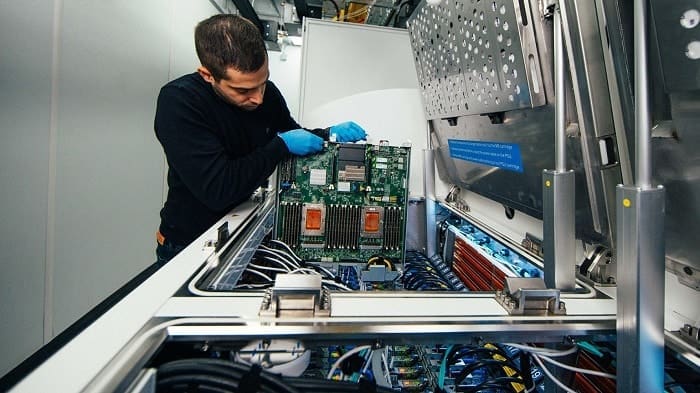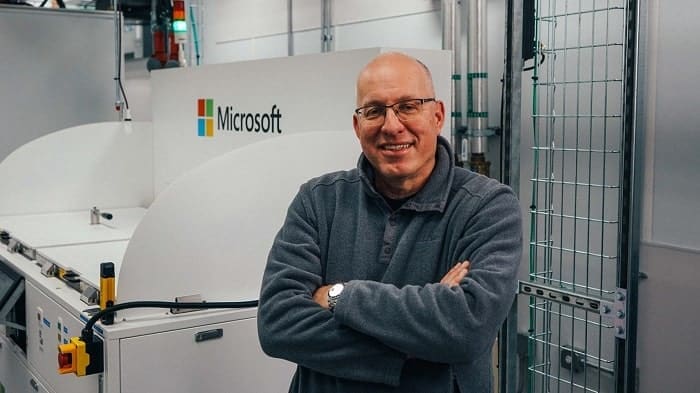Microsoft revealed that it is the first cloud provider that is exploring two-phase immersion cooling technology. The tech giant said this experiment is part of the company’s multi-pronged strategy to make datacentres more sustainable and efficient to build, operate and maintain.
The liquid cooling project is similar to Microsoft’s Project Natick, which is exploring the potential of underwater datacenters that are quick to deploy and can operate for years on the seabed sealed inside submarine-like tubes without any onsite maintenance by people.
Instead of an engineered fluid, the underwater datacentres is filled with dry nitrogen air. The servers are cooled with fans and a heat exchange plumbing system that pumps piped seawater through the sealed tube.
At a Microsoft data centre on the bank of the Columbia River in Washington state, engineers are submerging servers in a steel holding tank filled with boiling liquid.
Unlike water, the fluid inside the couch-shaped tank is harmless to electronic equipment and engineered to boil at 122 degrees Fahrenheit, 90 degrees lower than the boiling point of water.
The boiling effect, which is generated by the work the servers are doing, carries heat away from labouring computer processors. The low-temperature boil enables the servers to operate continuously at full power without the risk of failure due to overheating.
Inside the tank, the vapour rising from the boiling fluid contacts a cooled condenser in the tank lid, which causes the vapour to change to liquid and rain back onto the immersed servers, creating a closed-loop cooling system.
The production environment deployment of two-phase immersion cooling is the next step in Microsoft’s long-term plan to keep up with demand for faster, more powerful datacentre computers at a time when reliable advances in air-cooled computer chip technology have slowed.
For decades, chip advances stemmed from the ability to pack more transistors onto the same size chip, roughly doubling the speed of computer processors every two years without increasing their electric power demand.

This doubling phenomenon is called Moore’s Law after Intel co-founder Gordon Moore, who observed the trend in 1965 and predicted it would continue for at least a decade. It held through the 2010s and has now begun to slow.
That’s because transistor widths have shrunk to the atomic scale and are reaching a physical limit. Meanwhile, the demand for faster computer processors for high-performance applications such as artificial intelligence has accelerated, Husam Alissa, principal hardware engineer on Microsoft’s team for datacenter advanced development.
To meet the need for performance, the computing industry has turned to chip architectures that can handle more electric power. Central processing units, or CPUs, have increased from 150 watts to more than 300 watts per chip, for example. Graphics processing units, or GPUs, have increased to more than 700 watts per chip.
The more electric power pumped through these processors, the hotter the chips get. The increased heat has ramped up cooling requirements to prevent the chips from malfunctioning.
“Air cooling is not enough,” said Christian Belady, distinguished engineer and vice president of Microsoft’s datacenter advanced development group in Redmond.
“That’s what’s driving us to immersion cooling, where we can directly boil off the surfaces of the chip.”
Heat transfer in liquids, he noted, is orders of magnitude more efficient than air.
What’s more, he added, the switch to liquid cooling brings a Moore’s Law-like mindset to the whole of the datacenter.
“Liquid cooling enables us to go denser, and thus continue the Moore’s Law trend at the datacenter level,” he said.
Liquid cooling is also a waterless technology, which will help Microsoft meet its commitment to replenish more water than it consumes by the end of this decade.
The cooling coils that run through the tank and enable the vapor to condense are connected to a separate closed loop system that uses fluid to transfer heat from the tank to a dry cooler outside the tank’s container. Because the fluid in these coils is always warmer than the ambient air, there’s no need to spray water to condition the air for evaporative cooling, Alissa explained.
Microsoft, together with infrastructure industry partners, is also investigating how to run the tanks in ways that mitigate fluid loss and will have little to no impact on the environment.
“If done right, two-phase immersion cooling will attain all our cost, reliability and performance requirements simultaneously with essentially a fraction of the energy spend compared to air cooling,” said Ioannis Manousakis, a principal software engineer with Azure.



